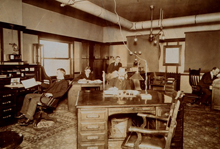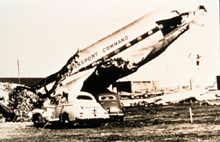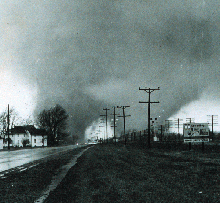Severe Weather Watches and Warnings
Forecasting of tornados and other severe storms by NOAA scientists has had varying levels of success throughout the years. NOAA's Storm Prediction Center and its predecessors have predicted and warned communities of these severe weather threats with ever increasing accuracy, saving countless lives and billions of dollars.
- Introduction
- Early Weather Observation
- Tornado Forecasts
- Severe Local Storms Unit
- From "Forecast" to "Watch"
- Conclusion

This tornado occurred in Kingsmill, Texas on May 14, 1977. The candy-striped appearance came from the tornado's passing across alternating areas of sun and shadow caused by broken clouds to its upper left. This tornado was in its dying stages, losing its circulation at ground level. The entire visible funnel would vanish within seconds. Click image for larger view.
Early settlers to this country knew all too well the harsh weather conditions of the eastern United States. From long, cold winters to fierce coastal storms, the life and death impact of severe weather often hit them with no warning.To minimize the negative effects of severe weather on communities, NOAA has been developing systems to provide advanced notice of severe weather for over 150 years. This article outlines the key events and innovations of NOAA's severe storm forecasting programs, most notably tornado watches and warnings.
Early Weather Observation
During the early and mid-1800s, weather observation networks began to grow and expand across the United States. The first weather observation network in the United States was established in 1848 by Joseph Henry, Secretary of the new Smithsonian Institution. Henry's network of volunteer observers used the telegraph system to warn "the more northern and eastern observers to be on the watch from the first appearance of an advancing storm."
A Government Weather Agency
Building on Henry's work, President Ulysses S. Grant signed a joint resolution of Congress on February 9, 1870, authorizing the Secretary of War to establish a government agency to observe and forecast the weather. Assigned to the U.S. Army Signal Corps under Brigadier General Albert J. Myer, this new weather service was called The Division of Telegrams and Reports for the Benefit of Commerce. This agency would later be renamed the Weather Bureau, and finally, the National Weather Service.

The Weather Bureau developed local forecasting offices around the country, like this one in Buffalo, New York, in January, 1899. Click image for larger view.
Myer's field stations telegraphed basic weather observations three times a day to Washington, DC. They also used a system of "wig-wag" flags to deliver storm warnings. Upon receiving word via telegraph that a storm was heading their way, Signal Corps members would raise a flag to warn the public about impending severe weather.
A Civilian Federal Service
In 1891, to resolve a dispute regarding civilian and military control of the weather service, the Weather Bureau became a civilian agency and was moved to the Department of Agriculture. The Weather Bureau remained in the Department of Agriculture until 1940, when it was moved to the Department of Commerce. In 1970, its name was changed to the National Weather Service and it became a part of the Department's newly created National Oceanic and Atmospheric Administration.
Throughout these reorganizations and name changes, the service was growing its ability to forecast and alert the public of impending severe weather.
Tornado Forecasts: Getting Started
Some of the first scientific investigations of tornadoes were done by Lieutenant John Finley of the Army Signal Corps. He started his tornado studies in 1878. Based on his studies, he progressed so far as to issue routine tornado forecasts for 18 regions of the country in 1884.
All told, Finley issued 2,803 forecasts, 100 of which called for tornadoes and the rest forecasted that no tornadoes would occur. Finley claimed these forecasts were accurate 95.6 to 98.6 percent of the time. Of course, had Finley simply forecast "no tornadoes" in all his forecasts, he would have been right 98.2 percent of the time!
In 1887, General William B. Hazen ordered the termination of tornado forecasting because it was "believed that the harm done by such a prediction would eventually be greater than that which results from the tornado itself."
The First Modern Tornado Forecast
On March 20, 1948, a tornado crossed the runways at Tinker Air Force Base near Oklahoma City, Oklahoma. This storm destroyed 117 aircraft and caused more than $10 million of damage. The base's commanding general instructed the base weathermen that such an event was never to occur again without a forecast.
In investigating the incident, Air Force Captain Robert C. Miller and Major Ernest J. Fawbush found several studies and reports on weather conditions associated with tornadoes. They noticed similarities between the March 20 weather pattern and the findings in these reports.
Five days later, Miller and Fawbush noticed the weather pattern for the day was very similar to the forecast on March 20, when the tornado had struck. When they took their news to the general, he asked if there was a good chance that a tornado would occur that day. After weighing their findings against the probability of another tornado hitting the same spot in less than a week, as well as the potential public backlash from an incorrect forecast, the weathermen answered "yes." Consequently, the general ordered them to issue the nation's first official tornado forecast.

The first tornado forecast occurred on the evening of March 25, 1948, when a tornado roared through Tinker Air Force Base, causing considerable damage, a few injuries, but no fatalities. Click image for larger view.
A few hours later, on the evening of March 25, 1948, a tornado roared through the air base, 100 yards from the track of the March 20 tornado. Rated F3 on the tornado classification, the tornado destroyed 35 aircraft and caused more than $6 million in damage; however, no one was killed and the destruction could have been worse.
This first tornado forecast was instrumental in advancing the nation's commitment to protecting the American public and military resources from the dangers caused by natural hazards.
The Weather Bureau's Severe Local Storms Unit
In response to public demand for tornado forecasts, in 1952, a Severe Local Storms (SELS) unit was established within the Weather Bureau. Their first tornado forecast, issued on March 17, 1952, called for tornadoes in east Texas, south Arkansas, and Louisiana. The forecast was close, but not perfect: tornadoes did occur in north central Texas, but not in Arkansas or Louisiana.
Four days later, SELS issued its second public tornado forecast, this time with more success: the majority of tornadoes occurred in the area the revised afternoon SELS forecast indicated. This model of putting out an early forecast and revising it as the day progressed is essentially the basis for today's watch and warning concept.
Missed Forecasts Lead to Increased Research
The next year, a series of devastating tornadoes occurred. While SELS put out forecasts for these tornadoes, the accuracy of these forecasts varied. During the year, powerful tornadoes inaccurately forecasted by SELS hit Texas, Mississippi, and Massachusetts, killing 320 people and injuring over 2,700 others. These misses led to intense research on topics such as the vertical structure of the atmosphere, typical tornadic weather patterns, and the role of the jet stream in severe weather.
Civilian tornado forecasts remained in relative obscurity until April 2 and 3, 1956. On these dates, SELS issued afternoon tornado watches in Wisconsin and lower Michigan. Four tornados occurred in the watch area - an F5, two F4s and an F3. The accuracy of this forecast was truly amazing, given that the unit had no centrally available radar, no computer model guidance, no satellite data, and limited communication capabilities. The forecasts issued for these four tornadoes demonstrated the potential for credible tornado forecasting.
Since the 1956 tornadoes, forecast capabilities have continued to improve with advances in storm analysis, Doppler radar, satellites and interactive computers, storm modeling, and greater understanding of interactions between storms and the environment.
From "Forecast" to "Watch"
The 1965 Palm Sunday tornado outbreak was a seminal event in tornado forecasting history and a turning point for the National Weather Service. During the outbreak, a massive double-funnel tornado near Dunlap, Indiana, between Goshen and Elkhart, killed 266 people despite the fact the tornadoes were generally well forecast. As a result, the Weather Bureau began to search for flaws in their system. They found the public did not know about and appreciate the Weather Bureau's capability to forecast tornadoes and did not understand the tornado hazard.
The survey team outlined an aggressive public education program, including the "Owlie Skywarn" program, which serves to warn child about the dangers of severe weather.

The 1965 Palm Sunday tornado outbreak was a turning point for the National Weather Service. A massive double-funnel tornado near Dunlap, Indiana, between Goshen and Elkhart, tore up everything in its path. Click image for larger view and image credit.
Also, following the Palm Sunday outbreak, three specific changes in tornado forecasting procedures occurred: the term "tornado watch" replaced "tornado forecast," the procedure used to define the area inside a watch was standardized, and the forecast of potential areas of severe thunderstorm activity was made a public product. A "watch" means severe weather is possible during the next few hours, while a "warning" means that severe weather has been observed, or is expected soon.
Advances in radar technology, and improved understanding of thunderstorm development, have produced improvements in tornado watch and warning lead times. Severe thunderstorms that generate tornadoes often produce large hail, lightning, and strong winds. These tornadoes can develop at any time of the year, but major outbreaks are often associated with the transition period between winter and spring and fall to winter.
Conclusion
While tornadoes and severe thunderstorms have always occurred throughout the United States, experiences in the mid-20th century helped forecasters develop the basic systems and tools to predict them and laid the groundwork for significant watch and warning improvements during the rest of the century.
